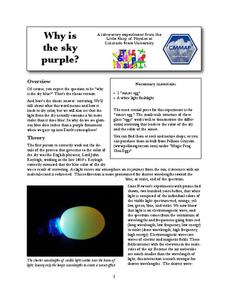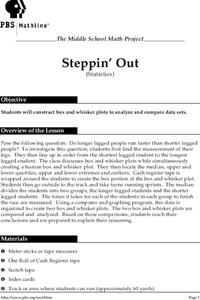Colorado State University
Why Is the Sky Purple?
The color of the sky depends on the time of day. Young scholars experiment with scattering different wavelengths of light to recreate the color of the sky. They observe both the longer blue wavelengths and the shorter red and orange...
Curated OER
Relations and Graphs
Here is a simple, yet clever lesson on how to teach the important concepts of greater than, less than, and equal to. Pupils write their names down on grid paper - one letter per box. They compare their names and find a name that is...
Curated OER
Steppin' Out
Students are presented with the question: "Do longer legged people run faster than shorter legged people?" Students conduct an experiment, collect their data, create box and whisker plots using a computer and graphing program, and...
Curated OER
In a Giants Garden
Learners explore the effect of the earths rotation and its relationship to the suns position and the effect that the longer and shorter amount of daylight has on a pumpkin plant which they have planted.
Curated OER
Structural Geology Laboratory
Young scholars explore modeling of geologic structures in experiments. They study how compressive and tensile forces produce these structures. The compression makes the flatlying strata shorter and tension make the strata longer.
Curated OER
Seed Selection for Genetic Variation
Students will research the origin of corn, analyze factors that contribute to shorter and longer growing seasons, and use the scientific method to answer the question: Did seed selection contribute to the successful movement of corn from...
Curated OER
Let's Do the Wave!
Students distinguish waves from matter, differentiate between transverse and longitudinal waves, use sine curves as representations of transverse waves, label characteristic properties of waves, diagram transverse waves having specific...
Curated OER
Special Right Triangles
Using the Pythagorean Theorem to solve for missing angles, young scholars evaluate right triangles and their properties.
Illustrative Mathematics
Dilating a Line
High School geometers verify through experimentation certain properties about dilations. This multi-step problem challenges them to construct examples of dilations to verify specific facts, the final step provides an opportunity to more...
Bowland
Pointzero: Confined
Groups plan their escape carefully. Three three-tiered puzzles help a story character escape their situation, each involving integer sequences, transformations, and geometric constructions. The teacher resource includes slides and...
Bowland
Explorers – Patrol Services
Far out — plan a trip to space! Aspiring mathematicians steer a space vehicle through an asteroid field, calculate currency exchanges to buy provisions, and determine placement of charges to blow up asteroids. Along the way, they learn...
Bowland
Mystery Tours – Plan Your Tour
Everyone loves a vacation and a set of three activities has groups planning a tour of the U.K. using given distance, time, and price data. They solve a variety of problems related to the trip and produce a report on the success of the trip.
Bowland
Outbreak: Infection Detection
Explore the mathematics of infection outbreaks with activities that ask learners to use coordinate grids to locate infected patients. They calculate amounts of ingredients for antidotes and determine which groups of people should be...
Curated OER
Science: Objects That Rotate with Gravity
Pupils conduct experiments in gravity by rolling objects down an incline and determining which ones roll slower than others. As part of the experiment, they design objects which will roll the slowest. Using digital movie cameras or...
Curated OER
Mass
Learners determine how mass is a property of an object that can be measured, and examine how size affects mass. They work with balances and determine what units of measurement are associated with mass. Finally, they determine the...
Curated OER
Volume
Students participate in a teacher demonstration of the water level in different beakers to investigate the measurement of volume. Next, working in small groups, they replicate the demonstration and determine how the measurements in the...
Curated OER
Volume
Third graders complete scientific investigation to determine what volume is and how it is determined by size not by mass. They discuss what they know about volume before proceeding with the demonstration and experimentation. After the...
Curated OER
Investigating Leaves Through Printmaking
Students create leaf rubbings as they study the parts of a leaf. They describe the leaves and chart their observations.
Curated OER
Counting Sentences' Words
Explore language arts by completing a worksheet with class. They read the story Owl Moon and discuss the rhythm of the writing and how action verbs are used appropriately. Then complete a writing worksheet which discusses writing...
Curated OER
Step Into My Shoes
Students order their classmates from smallest to largest foot length. In this ordering their classmates from smallest to largest foot length lesson, students trace each of their classmates foot. Students read a story called, 'How Big...
Curated OER
Classification and Identification
Young scholars, after exploring and analyzing diagrammatic and taxonomic keys and their association to marine sciences, identify and classify objects and organisms based on visual attributes/characteristics. They research and create...
Curated OER
This Is a Stick Up
Learners create a sundial and track the movement of the sun throughout the day. Modifications to the lesson are provided for both lower and upper elementary students.
Curated OER
Reading Fiction: Analyzing Sentences
Students investigate sentence construction in fiction. In this sentence construction lesson, students examine examples of fiction work and discover why sentences are a certain length. Students create their own passages playing with...
Curated OER
Paper Chromatography K-12 Experiment
Students study chromatography and how they can distinguish between the different pigments in a color. In this chromatography lesson students separate a mixture of dyes in soluble ink then record the colors they see.

























